Redefining Demand Feeding

Firstly, let’s start with the obvious - “demand feeding” or what is also called “responsive feeding” is the best way to feed a child, because I’m sure we would all agree it’s of course ideal to feed our newborn’s responsively, which according to the Merriam-Webster Dictionary means reacting appropriately or sympathetically. So, what needs redefining right? These labels totally encapsulate a respectful way to nurture feeding.
But one must then surely ask, and make sure, that the taught practices behind the labels actually answer the child’s holistic demand appropriately and sympathetically, yes? Stands to logic. For example, we can’t simply just label a cue as a hunger cue, and not acknowledge that it can also means a number of other natural demands, so may require another natural response – one that considers and encompasses nature’s holistic tools that would then be affected by our response, like the baby’s digestive system. So, what does that mean? Well, for me it means, we need to deliver care that is based on nature’s complete library of “cue-led communication” whilst understanding nature’s full-spectrum of digestive function – aka the main “tool” in the function of feeding that extends from mouth to bowel. Now some might say, “Yes. That’s what is currently being taught under the labels of “demand or responsive feeding.” But is it really? Or do we need to redefine our delivery and have a fresh, new label as we evolve our feeding practices for the benefit of newborn health? Let’s delve into it.
Newborn hunger cues…
Presently, most parents in the Western world will hear that the following cues are hunger cues. However, as many of you will instinctively already know, witnessing these “hunger cues” can be confusing at times, none-the-least at those times when you see the cues after having just fed your baby and all your instincts say, “But you can’t be hungry, I just fed you.” Well, your instincts are probably right. It’s more than likely that your baby is actually exhibiting the widely taught “hunger cues” for another reason…
Sucking on hands – while this may be a hunger cue, sucking on hands can also be about development. Perhaps baby has just found their hands and nature instinctively has them doing this so they can learn to control these movements. Or they are teething, so they naturally want to chew on their hands. Or they are self-soothing through pangs of digestive discomfort.
Lip smacking – this is highly misinterpreted as a hunger cue, but lip smacking is more-often than not accompanied by a baby poking out their tongue, which in fact means your baby is showing you one of their Six-Wind-Cues, communicating that they have trapped air sitting high in the stomach or esophagus that needs to be released through burping. If you feed at this time, generally baby will struggle to latch, or if they do, they will reflux quite soon after their feed because the pocket of air that wasn’t released before feeding, will push the milk out on its release. Otherwise, for older babies, lip smacking can be about their early exploration of actions creating sound.
3 Top Burping Tips
These three top tips may just surprise you for many parents around the world are taught to do these burping practices, but they actually hinder the release of trapped air in the stomach.


- Stimulating air release
- Recognise a wind-cue
- Beneficial positioning


WHAT'S INSIDE
- Stimulating air release
- Recognise a wind-cue
- Beneficial positioning
Opening and closing the mouth – well of course there are many things that can have a baby doing this like crying, having air ready to be released, teething, interaction with parents or environment, and when anything touches their cheeks or mouth, which then leads us onto one of the most misconstrued newborn cues…
Rooting to suck – this is one of the most misinterpreted hunger cues, because if babies are rooting, they are looking to suck. Let’s repeat that because it is an important sentence; rooting is about sucking. It is us that then attaches the thinking that sucking is always about hunger. Yes, baby may root to suck when they are hungry, but they also do this when they feel digestive movement (whether it’s painful or not) and to swallow essential salivary enzymes for digestion.
Move their eyes around – hmmm. Anyone else think that this is ambiguous? Do I really have to say that newborns move their eyes around for many reasons? However, what I do need to let you know is that if your baby is largely happy and starring off into space while moving their eyes around, then this is actually another Wind-Cue that I have discovered and named the Windy Stare. The Windy Stare also lets you know that your baby has a burp, or burps, that are ready to be released and you can do this by using the numerous positions and calming techniques in my ten-step-method of burping, called Nature’s Wind Sequence, which you can learn more about in my Free Burping Your Baby Well Coaching.
Wriggling and getting restless – this cue can also happen when baby is feeling natural or heightened levels of nutrients, air or waste moving through their tummy, intestines or bowel. It might also happen when baby is tired.
Crying – many parents are told that they should ideally feed their baby before they get to the crying stage. But this belief has parents presuming that crying means they have missed the window of opportunity and now their baby is highly hungry. This can lead to doubt, anxiety and a lack of confidence in the parent’s ability to read cues. Besides, while a very hungry baby might cry from hunger, usually they cry because they feel pain in the digestive system. Because a baby that has natural levels of hunger and is relatively comfortable with digestive function, tends to grizzle, whimper, and moan when hungry. Not cry or even scream. These are more pain cues, which would tend to only happen in regard to hunger if a child has been left too long between feeds, or there is an issue with transference when breastfed so they are indeed hungry and may have consumed excess air, or they are not being bottle fed to their natural feeding volumes for their age.
So, hopefully you can see how these cues are actually quite confusing. How can a parent seriously decipher if their baby is communicating hunger, when only using “cue-led communication”, right? And how can one then make sure we are not creating Digestive Overload symptoms (the real cause of colic, reflux, silent reflux, lactose and dairy overload, the witching hour and some cases of mis-diagnosis cow's milk protein intolerance) and excess weight gains from overfeeding? Or even impacts on weight gain through underfeeding. Well, this is why it is absolutely necessary for us to integrate knowledge and care from the perspective of “digestive understanding and balance” when it comes to making sure our newborns are comfortably receiving what they require with responsive feeding, and this is where the re-defining and evolving with a new label and holistic feeding practice really comes in.
Feed baby to physiological capacities
This BabyCues Guide outlines the amounts to feed a newborn and infant, up to one year of age, when nurturing with BabyCues Bio-logical Feeding methods, which means feeding baby every three-and-a-half to four hours, thus working alongside our children's natural digestive function.


- foster digestive health
- feed to natural capacities
- Reduce Digestive Overload Symptoms


nurture naturally
- foster digestive health
- feed to natural capacities
- Reduce Digestive Overload Symptoms
Newborn Digestive Understanding and Balance
When we open up our view of understanding newborn hunger to holistically include the research around newborn digestive function, coming from this perspective first-and-foremost, we can then confidently define if a baby is exhibiting hunger cues, as opposed to any of the other possibilities listed above. To do this, parents need to have a basic understanding of their newborns natural digestive processes. So, let's go over some of these now:
- Suck reflex
- Stomach capacity
- Migrating Motor Complex
- Intestinal absorption
Now in the interests of keeping this article a lot shorter than it could be, because of course there is a lot to talk about within these five digestive functions, I’ve decided to touch on the most basic aspects of each of these.
Suck reflex - As mentioned above, the suck reflex is just that. A reflex. It’s an involuntary reaction that happens for many reasons, including it being a newborns natural mechanism to sooth, and I feel that the redefining of this within postnatal teachings is paramount if we are to keep our newborns comfortable. So, one might then ask, how can we then tell the difference between rooting to suck for hunger, or comfort? Well, for this we must turn to the following knowledge and research.
Stomach capacity - As we know, the stomach plays a critical role in the early stages of milk digestion for your baby as it secretes gastric juice which comprises of water, mucus, hydrochloric acid, pepsin, and intrinsic factor.1 When looking at the capacities of a baby’s stomach it’s important to distinguish between filling them to their physiological and anatomical capacities. So, the first of these is ideally what all newborns would be fed to, because this is feeding to volumes that the stomach can comfortably hold without causing discomfort or high intra-gastric pressures. However, with demand feeding, where parents are being taught that feeding baby every one to three hours is fine and natural, newborns are largely being fed to their anatomical capacities which is what the stomach can hold after stretching and reaching high intra-gastric pressures and discomfort. When these levels occur, a babies milk will be pushed out of the stomach before it has had a chance to be broken down, despite the fact that “stomach emptying and transit times are naturally delayed for neonates”2 Add to this that formula companies are not regulated on the volumes they share on their cans for different ages, and these are often “significantly greater than what literature recommends”3 and of course, if baby is in pain they are going to look to root and suck more, thus creating the premise that yes, my baby needs to feed every 1-3 hours because they are showing “hunger cues”, and we again see that the redefining of “demand feeding” needs to happen and “digestive understanding and balance” needs to be the fundamental basis that these changes rest on.
Migrating Motor Complex - The migrating motor complex (MMC), also called the migrating myoelectric complex, is a mechanical and chemical cleansing of the empty stomach in preparation for the next meal, or what can also be described as the pattern of motility during the interdigestive period.4 The interdigestive period, first described by Boldyreff in 1911, follows the digestive period and begins after the upper gastrointestinal tract is cleared of food. The interdigestive period is interrupted and converted to the digestive pattern by eating, and interruption continues as long as food is in the stomach5. Now of course if babies are being feed every 1 to 3 hours, they tend to always have food in the stomach, and so this “impairs gastric MMC and aggravates postprandial dyspeptic symptoms.” What is that I hear you ask? Well, it’s also known as indigestion for adults, or as I have named it for newborns, Digestive Overload. Studies have shown that in adults, fullness and bloating were the first symptoms of dyspepsia to peak after meals; nausea and burping peaked next; pain and burning peaked last, and pain was the most intense symptom in patients whose symptoms were not aggravated by meals.6 Hmmmm, doesn’t that sound a lot like “reflux” symptoms? And given that newborns struggle to burp without help, and many parents get taught that you don’t need to burp after feeds, or only burp them a few times, despite newborns swallowing air with every mouthful, isn’t it no wonder that they are rooting to suck a lot because of pain? So, I reiterate, our newborns need us to redefine “demand feeding” as it is known if we are to combat one of the major causes of Digestive Overload symptoms, which is overfeeding and/or feeding beyond the capabilities and capacities of a newborns digestive system.
Intestinal absorption - The intestines are responsible for breaking food down, absorbing its nutrients and solidifying the waste. The small intestine is the longest part of the GI tract, and it is where most digestion takes place. The muscle movements of the small intestine help break food down and process it through your body. If these movements are impaired through rapid emptying of stomach contents bringing poorly digested milk, a baby may experience indigestion symptoms (abdominal pain, nausea and vomiting – aka refluxing - surprise, surprise) nutrient deficiencies, and malabsorption, resulting in diarrhea or constipation, weight changes, nutritional imbalances, disrupt the gut microbiome, and affect overall health and immune function.7, 8 Also, if nutrients are not digested appropriately then they cannot be absorbed into his blood stream by the ileum. This then leaves undigested nutrients to pass through to the large intestine and bowel, causing further discomfort and creating more gas, which can cause excruciating pain for our newborns.
Summary
With the confusion that surrounds the current taught hunger cues, the digestive research, along with the dire need to end baby obesity and stop millions of newborns that are suffering with Digestive Overload, I’m hoping beyond hope, for the sake of our newborn's health, that you too can now see, and agree that we do indeed need to redefine the knowledge behind the terms “demand or responsive feeding.”
Or… create a fresh new label that holistically encompasses logic, whilst drawing a line through our mis-directed teachings. Well, that’s what I have done. I have created BabyCues Bio-logical Feeding (life-logical feeding) and have now supported thousands of parents around the world to deliver this to their baby, stopping the symptoms of Digestive Overload. So now I’m on a mission to have this truly responsive and respectful way of feeding taught to parents as best practice – because that’s what our newborns deserve. You can find out how to do this for your baby via a 1:1 virtual consultation with me or purchase my Prevent and Remedy Book. And if you can offer any help, by sharing this article with others, please make that happen. I know thousands of newborns and parents that would appreciate that.
1. Physiology, Pepsin; Rajiv Heda; Fadi Toro; Claudio R Tombazzi
2. The Anatomical Basis of Clinical Practice, Gray's Anatomy 39th Edition
3. Newborn feeding recommendations and practices increase the risk of development of overweight and obesity (2020) Brittany Watchmaker, Bridget Boyd, Lara R Dugus
4. Takahashi T. Interdigestive migrating motor complex -its mechanism and clinical importance. J Smooth Muscle Res. 2013;49:99-111. doi: 10.1540/jsmr.49.99. PMID: 24662475; PMCID: PMC5137267.
5. Regulation of Interdigestive Gastrointestinal Motility and Secretion; Gastroenterology, Eugene P. DiMagno Digestion (1997)
6. Postprandial Symptoms in Functional Dyspepsia
David J. Bjorkman, MD, MSPH (HSA), SM (Epid.), reviewing Bisschops R et al. Gut 2008 Nov 2009
7. Cleveland Clinic, Small Intestine, Reviewed 2021
8. Care Hospitals, 5 signs Your Digestive system is not working properly (2020)


 Submitting data
Submitting data